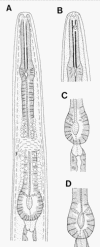
Rhabdolaimus terrestris De Man, 1880
Drawings from Botha and Heyns, 1993 |
Females:
-
Small nematodes 0.4-0.65 mm
long
-
Cuticle with fine transverse
striae in subcuticle.
-
Lips fused and rounded with
indistinct papillae
-
Stoma tubular with
sclerotized walls; small denticles at base of stoma.
-
Muscular basal bulb of
esophagus with valve apparatus.
-
Cardia at base of esophagus.
-
Tail elongate-conoid,
tapering to a bluntly-rounded terminus.
-
Female diovarial,
amphidelphic with short, reflexed ovaries; Vulva a transverse slit.
Male not seen.
|